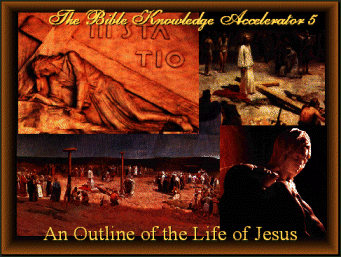

 |
|


| C | aesarea Philippi in the Time of Jesus |
Mark 8:27 "And Jesus went out, and his disciples, into the towns of Caesarea Philippi: and by the way he asked his disciples, saying unto them, Whom do men say that I am?"
During the time of Jesus Caesarea Philippi was located in the land of Israel far north above the Sea of Galilee. It was 1150 feet above sea level and located at the foot of Mount Hermon. One of the primary sources of the Jordan River came from an unusual cave at Caesarea Philippi which gushed forth water in ancient times. Inside the cave there was also a pit which was so deep that the bottom could not be discovered. It was such a natural place that many ancient cultures worshiped there. The ancient Canaanites worshiped there, and later the Greeks build a shrine there dedicated to the God Pan (it's Greek name was Paneas), and Alexander the Great knew of the place. It was on the flat plain below the terrace at Caesarea Philippi that the Seleucids defeated the Ptolemies in 200 BC and they took control of the land of Israel. Later during the time of the Roman Empire Augustus Caesar visited there and even erected a temple there. There are many archaeological remains at the site of ancient Caesarea Philippi. Augustus gave the city to Herod the Great, and later when he died it was given to his son Philip who rebuilt it, and made it his capital city. Caesarea Philippi was the last place Jesus came to before he went to Jerusalem to be lifted up. It was here at Caesarea Philippi that Jesus revealed who he was and that he was going to die. He asked his disciples, "who do you say that I am?" and Peter acknowledged Jesus as the Messiah, and Jesus anounced his death to them and the building of his Church. He said that "the gates of Hades" will not prevail against it. (Matthew 16:18).
Caesarea Philippi is mentioned only in the first two Gospels, Mt 16:13; Mr 8:27 and in accounts of the same transactions. It was at the easternmost and most important of the two recognized sources of the Jordan, the other being at Tel-el-Kadi. The spring rises from and the city was built on a limestone terrace in a valley at the base of Mount Hermon 20 miles north of the Sea of Galilee. It was enlarged by Herod Philip, and named after Caesar, with his own name added to distinguish it from Caesarea. Its present name is Banias, a village of some 50 houses, with many interesting ruins. Caesarea Philippi has no Old Testament history, though it has been not unreasonably identified with Baal-gad. It was visited by Christ shortly before his transfiguration, Mt 16:13-28 and was the northern limit of his journeys. Mr 8:27 - Smith's Bible Dictionary
![]()
Historical Notes
- CAESAR'EA PHIL'I'PI (caes-ar-ia phil-i-pi; Gk. City dedicated to Caesar and Philip).
- During the time of Jesus it was called Paneas and was very pagan.
- Herod Philip the Tetrarch enlarged the city and renamed it Caesarea Philippi after Caesar Augustus and himself, and to distinguish it from Caesarea Maritima located on the Mediterranean Sea coast. Augustus had alloted a portion of his father Herod's kingdom to him and Philip wished to honor him.
- Herod Philip the Tetrarch was son of Herod the Great and his 5th wife Cleopatra of Jerusalem.
- It was a place of many pagan rituals.
- Many believe that Mount Hermon was the place of the transfiguration.
- It was here that Jesus said "Upon this rock I will build my Church and the Gates of Hades shall not prevail against it." (Matt 16:13-18; Mark 8:27-33).
- Roman troops slaughtered many Jews there during the first Jewish revolt (66-70
AD).
Related Topics: Sea of Galilee, Jordan River, Mount Hermon, Peter, James, John, Jesus, the Transfiguration.
Picture Study Bible
- Mark 8
Ancient
Caesarea Philippi
Jesus Resources
![]()
Read The Bible
- 1599 Geneva Bible (GNV)
- 21st Century King James Version (KJ21)
- American Standard Version (ASV)
- Amplified Bible (AMP)
- Amplified Bible, Classic Edition (AMPC)
- Authorized (King James) Version (AKJV)
- BRG Bible (BRG)
- Christian Standard Bible (CSB)
- Common English Bible (CEB)
- Complete Jewish Bible (CJB)
- Contemporary English Version (CEV)
- Darby Translation (DARBY)
- Disciples’ Literal New Testament (DLNT)
- Douay-Rheims 1899 American Edition (DRA)
- Easy-to-Read Version (ERV)
- English Standard Version (ESV)
- English Standard Version Anglicised (ESVUK)
- Evangelical Heritage Version (EHV)
- Expanded Bible (EXB)
- GOD’S WORD Translation (GW)
- Good News Translation (GNT)
- Holman Christian Standard Bible (HCSB)
- International Children’s Bible (ICB)
- International Standard Version (ISV)
- J.B. Phillips New Testament (PHILLIPS)
- Jubilee Bible 2000 (JUB)
- King James Version (KJV)
- Lexham English Bible (LEB)
- Living Bible (TLB)
- Modern English Version (MEV)
- Mounce Reverse Interlinear New Testament (MOUNCE)
- Names of God Bible (NOG)
- New American Bible (Revised Edition) (NABRE)
- New American Standard Bible (NASB)
- New American Standard Bible 1995 (NASB1995)
- New Catholic Bible (NCB)
- New Century Version (NCV)
- New English Translation (NET)
- New International Reader's Version (NIRV)
- New International Version - UK (NIVUK)
- New International Version (NIV)
- New King James Version (NKJV)
- New Life Version (NLV)
- New Living Translation (NLT)
- New Matthew Bible (NMB)
- New Revised Standard Version (NRSV)
- New Revised Standard Version Catholic Edition (NRSVCE)
- New Revised Standard Version, Anglicised (NRSVA)
- New Revised Standard Version, Anglicised Catholic Edition (NRSVACE)
- New Testament for Everyone (NTE)
- Orthodox Jewish Bible (OJB)
- Revised Geneva Translation (RGT)
- Revised Standard Version (RSV)
- Revised Standard Version Catholic Edition (RSVCE)
- The Message (MSG)
- The Voice (VOICE)
- Tree of Life Version (TLV)
- World English Bible (WEB)
- Worldwide English (New Testament) (WE)
- Wycliffe Bible (WYC)
- Young's Literal Translation (YLT)
Table of Contents
Main Menu
- Ancient Assyrian Social Structure
- Ancient Babylonia
- Ancient Canaan During the Time of Joshua
- Ancient History Timeline
- Ancient Oil Lamps
- Antonia Fortress
- Archaeology of Ancient Assyria
- Assyria and Bible Prophecy
- Augustus Caesar
- Background Bible Study
- Bible
- Biblical Geography
- Fallen Empires - Archaeological Discoveries and the Bible
- First Century Jerusalem
- Glossary of Latin Words
- Herod Agrippa I
- Herod Antipas
- Herod the Great
- Herod's Temple
- High Priest's in New Testament Times
- Jewish Literature in New Testament Times
- Library collection
- Map of David's Kingdom
- Map of the Divided Kingdom - Israel and Judah
- Map of the Ministry of Jesus
- Matthew Henry Bible Commentary
- Messianic Prophecy
- Nero Caesar Emperor
- Online Bible Maps
- Paul's First Missionary Journey
- Paul's Second Missionary Journey
- Paul's Third Missionary Journey
- Pontius Pilate
- Questions About the Ancient World
- Tabernacle of Ancient Israel
- Tax Collectors in New Testament Times
- The Babylonian Captivity
- The Black Obelisk of Shalmaneser
- The Books of the New Testament
- The Court of the Gentiles
- The Court of the Women in the Temple
- The Destruction of Israel
- The Fall of Judah with Map
- The History Of Rome
- The Incredible Bible
- The Jewish Calendar in Ancient Hebrew History
- The Life of Jesus in Chronological Order
- The Life of Jesus in Harmony
- The Names of God
- The New Testament
- The Old Testament
- The Passion of the Christ
- The Pharisees
- The Sacred Year of Israel in New Testament Times
- The Samaritans
- The Scribes
Ancient Questions
- Why Do the Huldah Gates Appear Different in Ancient Replicas and Modern Photos?
- What Is the Origin of the Japanese and Chinese Peoples? A Biblical Perspective
- How did the ancient Greeks and Romans practice medicine and treat illnesses?
- What were the major contributions of ancient Babylon to mathematics and astronomy?
- How did the ancient Persians create and administer their vast empire?
- What were the cultural and artistic achievements of ancient India, particularly during the Gupta Empire?
- How did ancient civilizations like the Incas and Aztecs build their remarkable cities and structures?
- What were the major trade routes and trading practices of the ancient world?
- What was the role of slavery in ancient societies like Rome and Greece?
- How did the ancient Mayans develop their sophisticated calendar system?
Bible Study Questions
- Why Do Christians Celebrate Christmas?
- How Many Chapters Are There in the Bible?
- The Five Key Visions in the New Testament
- The 400-Year Prophecy: Unpacking Genesis 15 and the Journey of a People
- The Authorized (King James) Version (AKJV): Historical Significance, Translation Methodology, and Lasting Impact
- Exploring the English Standard Version (ESV): Its Aspects, Comparisons, Impact on Biblical Studies, and Church Use
- A Detailed Historical Analysis of Language Updates in the KJ21: Comparison with Other Versions
- A Detailed Historical Analysis of the American Standard Version (ASV): Comparison to the King James Version, Influence on Later Translations, and Evaluation of Strengths and Weaknesses
- A Detailed Historical Analysis of Amplifications in the Amplified Bible (AMP) and Its Comparison to Other Bible Translations
- Detailed Historical Analysis of the Amplified Bible Classic Edition (AMPC): Examples of Amplifications and Comparative Analysis with Other Bible Translations
About
Welcome to Free Bible: Unearthing the Past, Illuminating the Present! Step into a world where ancient history and biblical narratives intertwine, inviting you to explore the rich tapestry of human civilization.
Discover the captivating stories of forgotten empires, delve into the customs and cultures of our ancestors, and witness the remarkable findings unearthed by dedicated archaeologists.
Immerse yourself in a treasure trove of knowledge, where the past comes alive and illuminates our understanding of the present.
Join us on this extraordinary journey through time, where curiosity is rewarded and ancient mysteries await your exploration.
Recent posts
-

Faro Property Investment: A Gateway to Growth in Portugal’s Southern Coast
Introduction: Faro’s Growing Investment Appeal Faro property investment is gaining strategic attention among international investors seeking value-d... -

How Pallet Restacking Supports ESG Goals in the U.S. Industrial Sector and Drives Long-Term Value in Warehousing
Pallet restacking plays a pivotal role in supporting Environmental, Social, and Governance (ESG) goals across the U.S. industrial sector. As businesse... -

How Platzi AI Hiprex Trading Algorithms Are Outperforming Human Investors in 2025
The financial markets of 2025 are quicker, more complex, and extra records-pushed than ever earlier than. In this high-speed environment, even the max... -

Retail Traders Gain Edge with Quantum AI-Powered Market Insights
In these days’s hastily evolving monetary markets, technology is no longer only a device—it’s a competitive benefit. While institutional traders... -

Quantum AI Sets New Standard in Predictive Trading Accuracy
The monetary international isn't any stranger to change, but few innovations have disrupted conventional buying and selling pretty like synthetic inte...